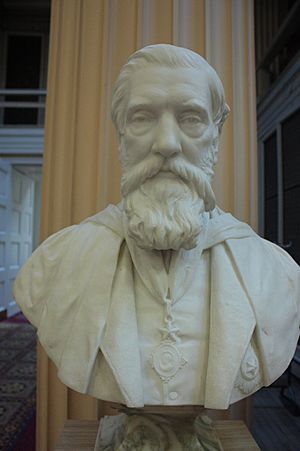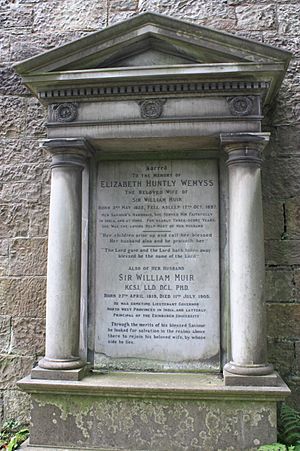William Muir facts for kids
Sir William Muir (born April 27, 1819 – died July 11, 1905) was an important Scottish person who studied the history and cultures of the East. He also worked as a leader in British India. Later, he became the head of the University of Edinburgh in Scotland.
Contents
Early Life and Career
William Muir was born in Glasgow, Scotland. His father was a merchant named William Muir, and his mother was Helen Macfie. He had an older brother named John Muir, who was famous for studying ancient Indian languages and cultures.
William Muir went to school at Kilmarnock Academy and then studied at the universities of Glasgow and Edinburgh. He also attended Haileybury College, which was a special school for people who wanted to work for the British government in India.
In 1837, William Muir began his career in the British government in Bengal, India. He worked as a secretary for the governor of the North-West Provinces. He also helped manage taxes and money as part of the Agra revenue board. During the Indian Mutiny (a big rebellion against British rule), he was in charge of getting important information for the government.
In 1865, he became the foreign secretary for the Indian Government, which meant he handled relationships with other countries. In 1867, he was given the special title of Knight, becoming "Sir William Muir." In 1868, he became the Lieutenant-Governor of the North Western Provinces, a very important leadership role.
Helping During Famines
After a terrible famine in 1866, people criticized how the British government handled it. William Muir then made a clear rule in 1868. He said that every local officer would be personally responsible. They had to make sure no one died from hunger if it could have been stopped by their efforts.
In 1874, Muir was chosen to manage the money for the Viceroy's Council, which was like the main government group in India. He retired in 1876 and then became a member of the Council of India in London. A man named James Thomason was a mentor to Muir. Muir later wrote a book about Thomason's life and work.
Focus on Education
William Muir was very interested in education. Because of his hard work, a central college was built in Allahabad, India. This college was named Muir Central College in his honor. It later became a part of the University of Allahabad.
In 1884, Muir was chosen to be the president of the Royal Asiatic Society, a group that studies Asia. In 1885, he became the head, or Principal, of the University of Edinburgh in Scotland. He held this important job until he retired in 1903.
Personal Life
On February 7, 1840, William Muir married Elizabeth Huntly. They had 15 children together. He passed away in Edinburgh in 1905 and is buried in Dean Cemetery.
Statues and Family
A marble statue of Sir William Muir was made by George Blackall Simmonds. It was put up at the opening of Muir Central College on April 8, 1886. This statue was still there in 2012.
William Muir's brother was John Muir, who studied Indian history and languages. William and Elizabeth had five sons and six daughters. Four of their sons worked in India. One son, Colonel A. M. Muir, was a political officer in Baluchistan and worked in Nepal before he died. One of his daughters, Jane, married Colonel Andrew Wauchope. One of his sons-in-law was a government worker named William Henry Lowe.
See also
- Orientalism
- Origin and development of the Qur'an



